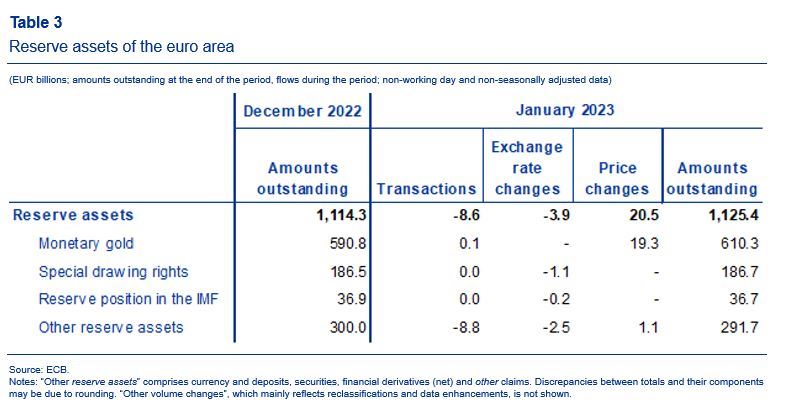- Current account recorded €17 billion surplus in January 2023, up from €13 billion in previous month
- Current account deficit amounted to €98 billion (0.7% of euro area GDP) in 12 months to January 2023, compared with a surplus of €252 billion (2.0%) one year earlier
- In financial account, euro area residents’ net sales of non-euro area portfolio investment securities totalled €238 billion and non-residents’ net acquisitions of euro area portfolio investment securities totalled €80 billion in 12 months to January 2023

The current account of the euro area recorded a surplus of €17 billion in January 2023, an increase of €4 billion from the previous month (Chart 1 and Table 1). Surpluses were recorded for services (€14 billion), goods (€11 billion) and primary income (€1 billion). These were partly offset by a deficit for secondary income (€9 billion).

Dataforthecurrentaccountoftheeuroarea
In the 12 months to January 2023, the current account recorded a deficit of €98 billion (0.7% of euro area GDP), compared with a surplus of €252 billion (2.0% of euro area GDP) in the 12 months to January 2022. This change in the current account balance was mainly driven by a switch from a surplus (€246 billion) to a deficit (€68 billion) for goods, and, to a lesser extent, by a reduction in the surplus for primary income (down from €59 billion to €7 billion) and a slightly larger deficit for secondary income (up from €158 billion to €161 billion). These developments were partly offset by a larger surplus for services (up from €104 billion to €123 billion).

In direct investment, euro area residents made net disinvestments of €72 billion in non-euro area assets in the 12 months to January 2023, following net investments of €143 billion in the 12 months to January 2022 (Chart 2 and Table 2). Non-residents disinvested €220 billion in net terms from euro area assets in the 12 months to January 2023, following net disinvestments of €81 billion in the 12 months to January 2022.
In portfolio investment, euro area residents’ net sales of non-euro area equity amounted to €210 billion in the 12 months to January 2023, following net purchases of €358 billion in the 12 months to January 2022. Over the same period, net sales of non-euro area debt securities by euro area residents amounted to €29 billion, following net purchases of €378 billion in the 12 months to January 2022. Non-residents’ net purchases of euro area equity decreased to €50 billion in the 12 months to January 2023, down from €579 billion in the 12 months to January 2022. Over the same period, non-residents’ net purchases of euro area debt securities amounted to €30 billion, following net sales of €235 billion in the 12 months to January 2022.

Data for the financial account of the euro area
In other investment, euro area residents recorded net acquisitions of non-euro area assets amounting to €144 billion in the 12 months to January 2023 (following net acquisitions of €262 billion in the 12 months to January 2022), while their net incurrence of liabilities decreased to €29 billion (down from €774 billion in the 12 months to January 2022).

The monetary presentation of the balance of payments (Chart 3) shows that the net external assets (enhanced) of euro area MFIs decreased by €95 billion in the 12 months to January 2023. This decrease was driven by euro area non-MFIs’ net outflows in other investment, direct investment and other flows. These developments were partly offset by euro area non-MFIs’ net inflows in portfolio investment equity and debt and, to a lesser extent, by the current and capital accounts surplus.
In January 2023 the Eurosystem’s stock of reserve assets increased to €1,125.4 billion, up from €1,114.3 billion in the previous month (Table 3). This increase was mainly due to positive price changes (€20.5 billion) and, to a lesser extent, other volume changes (€3.1 billion) due to the inclusion of the reserve assets of Hrvatska narodna banka following the introduction of the euro in Croatia, which were partly offset by net sales of assets (€8.6 billion) and by negative exchange rate changes (€3.9 billion).

Dataforthereserveassetsoftheeuroarea
The inclusion of Croatia in euro area external statistics
When Croatia adopted the euro on 1 January 2023, its economic agents became euro area residents. This press release shows, for the first time, time series for the balance of payments of the enlarged euro area, starting from the reference period January 2013. In addition, quarterly euro area international investment position statistics have been recalculated to reflect the new composition of the euro area.
The changes to euro area external statistics due to the enlargement involve: (i) including transactions and positions between residents in Croatia and non-euro area residents; and (ii) excluding transactions and positions between euro area residents and residents in Croatia. In general, Croatia’s accession has had a minor impact on the aggregate euro area figures.
Data revisions
This press release incorporates revisions to the data since January 2013, reflecting the inclusion of Croatia in the euro area aggregates. These revisions did not significantly alter the figures previously published.
ecb.europa.eu


















